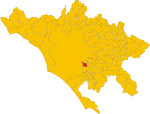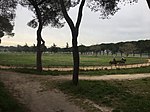Fiorano (wine)
Fiorano was an Italian wine-producing estate owned by Alberico Boncompagni Ludovisi, a prince of Venosa of the Ludovisi family, active during a period from the late 1940s to 1995. Fiorano is situated in the vicinity of Rome near the Via Appia Antica in the Latium district. Famed wine writer Burton Anderson dubbed Fiorano's wines 'the noblest Romans of them all' in his 1980 anthology Vino. The estate, its methods, wines and its proprietor were all noted for their unorthodoxy in comparison to norms of the wine industry. Though limited in terms of fame, the red wine and two white wines produced at Fiorano during its period of activity achieved reputations for innovation and longevity. Since the late 1960s a small number of devout 'cognoscenti', especially among restaurant owners in Rome, knew about the extraordinary qualities of the two whites Fiorano Bianco (100% Malvasia) and Fiorano Riserva Semillon, and overcame numerous obstacles in order to get the wines.
Excerpt from the Wikipedia article Fiorano (wine) (License: CC BY-SA 3.0, Authors).Fiorano (wine)
Via di Fioranello, Rome Castel di Leva
Geographical coordinates (GPS) Address Nearby Places Show on map
Geographical coordinates (GPS)
| Latitude | Longitude |
|---|---|
| N 41.7945562 ° | E 12.5756459 ° |
Address
Via di Fioranello
Via di Fioranello
00134 Rome, Castel di Leva
Lazio, Italy
Open on Google Maps










